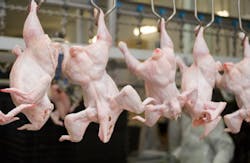Records released by the U.S. Department of Agriculture (USDA) show that every year almost 1 million chickens and turkeys leave fast-moving lines alive and are dropped into scalding water while still breathing. Under a new proposal from the USDA, currently being finalized, the rate at which lines at slaughterhouses are moving can be increased so that plants can become more efficient. But this could further aggravate the problem of inhumane treatment of birds, experts and government inspectors have claimed, according to The Washington Post.
USDA inspectors who work at poultry plants explained that plant workers put the birds upside down, shackled by their legs. The birds are then transported by a rapidly moving line to an automated blade that slaughters them and they are then placed in scalding water. Since plant workers have to hurry, they sometimes fail to secure the birds properly and they can elude the blade, ending up in the hot water still alive. Inspectors say that identifying the birds that were boiled alive is easy because of the discoloration of their skin. According to USDA records, over the past five years the annual average of birds that are killed this way is 825,000 chickens and 18,000 turkeys.
RELATED: Increase in line speed at poultry plants could cause more injuries, contamination
Mohan Raj, a poultry-slaughter expert who also advises the European Food Safety Authority, told the Washington Post that one of the biggest threats for inhumane treatment of birds is fast line speed and there is very little that employees at plants or inspectors can do to stop the abuse because lines move at a rate of 140 birds per minute in chicken plants and 45 per minute at turkey plants. Under USDA plans, this is about to increase to 170 and 55, respectively.
